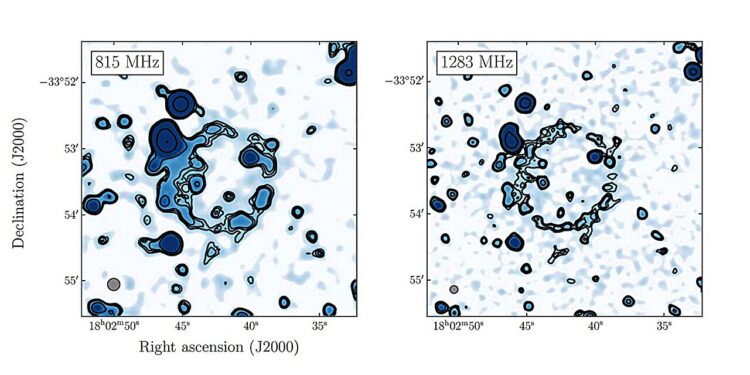Continuous MeerKAT images of Kýklos (J1802–3353) in UHF (left) and L-band (right), at the reference frequencies of 815 and 1283 MHz. Credit: Bordiu et al, 2024
An international team of astronomers has announced the serendipitous discovery of a new radio ring toward the galactic center. The newly discovered object is relatively faint and its true nature is still unknown. The discovery was reported in a research paper to be published in the Astronomy and astrophysics newspaper.
Recent large-scale radio continuum studies have revealed the presence of faint, ring-shaped radio sources, often associated with the late stages of stellar evolution. These odd radio circles (ORCs) are typically mysterious, gigantic rings of radio waves whose origin remains unexplained.
A new source of this type, which resembles an ORC, has been discovered by a group of astronomers led by Cristobal Bordiu of the Catania Observatory in Italy. The source, designated J1802–3353 and nicknamed Kýklos (meaning “circle” in Greek), was detected with the MeerKAT radio telescope.
“We present the serendipitous discovery of a new radio-continuum ring-shaped object nicknamed Kýklos (J1802–3353), with MeerKAT UHF and L-band observations,” the researchers wrote in the paper.
Kýklos was identified by Bordiu’s team at about 6.0 degrees from the galactic plane and close (in projection) to the galactic center. The object has a diameter of about 80 arcseconds and a thickness of about six arcseconds.
In MeerKAT total intensity maps, Kýklos appears as a pale, lumpy, almost circular annular structure. The appearance of the ring resembles a shell with illuminated limbs, the interior of which is devoid of detectable emissions.
Morphologically, Kýklos resembles a strange radio circle. However, it is located at a much lower galactic latitude than the known ORCs. Furthermore, it is also an order of magnitude fainter at 1.0 GHz and has a much flatter spectral index compared to the population of detected ORCs.
Astronomers are therefore considering several other hypotheses that could explain the nature of Kýklos: a galactic supernova remnant, a planetary nebula, a nova remnant and a circumstellar shell around an evolved massive star.
Based on the analysis of the collected data, the authors of the study concluded that Kýklos, being a circumstellar shell around a possible Wolf-Rayet (WR) star, is the most plausible scenario.
“Based on the limited data currently available, the morphological and spectral features of Kýklos appear most consistent with those of a WR shell. This interpretation is further supported by the absence of a detectable central point source in the L-band image,” the scientists explained.
Follow-up multi-wavelength observations are needed to fully characterize Kýklos and identify a possible central source, which could confirm the WR shell hypothesis.
More information:
Cristobal Bordiu et al., MeerKAT reveals ghostly thermal radio ring towards the galactic center, Astronomy and astrophysics (2024). DOI: 10.1051/0004-6361/202450766. On arXiv: DOI: 10.48550/arxiv.2408.07727
© 2024 Science X Network
Quote: MeerKAT observations detect mysterious faint radio ring (2024, August 21) retrieved 2024 August 21 from
This document is subject to copyright. Apart from any fair dealing for the purpose of private study or research, no part may be reproduced without written permission. The content is provided for informational purposes only.



